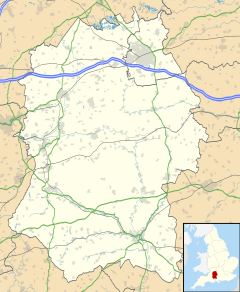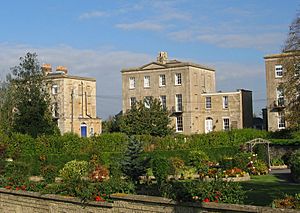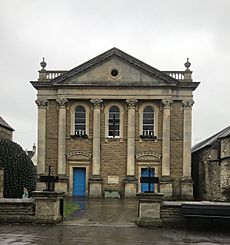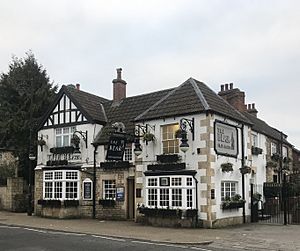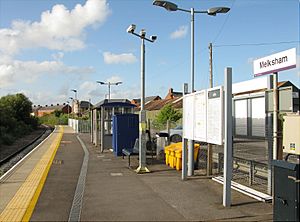Melksham facts for kids
Quick facts for kids Melksham |
|
|---|---|
 Melksham Town Hall and marketplace |
|
| Population | 18,113 (2021) |
| OS grid reference | ST9063 |
| Civil parish |
|
| Unitary authority |
|
| Ceremonial county | |
| Region | |
| Country | England |
| Sovereign state | United Kingdom |
| Post town | Melksham |
| Postcode district | SN12 |
| Dialling code | 01225 |
| Police | Wiltshire |
| Fire | Wiltshire |
| Ambulance | Great Western |
| EU Parliament | South West England |
| UK Parliament |
|
Melksham is a lively town in Wiltshire, England. It sits right on the River Avon. The town is about 7 kilometers (4.5 miles) northeast of Trowbridge and 10 kilometers (6 miles) south of Chippenham. In 2021, about 18,113 people lived in Melksham.
Contents
History of Melksham
Early Beginnings
People have lived in the Melksham area for a very long time. In 2021, during some digging at Melksham House, scientists found pieces of pottery. These pieces were made by local people during the early Iron Age, which was from the 7th to 4th centuries BC.
There is also proof that people lived here during the later Iron Age and Roman times. They even found Roman clay roof tiles. Melksham grew up around a place where people could cross the River Avon. The name "Melksham" probably comes from old English words meaning "milk village."
Past Owners of Melksham
In 1268, King Henry III of England gave the land of Melksham to Amesbury Abbey. This was a religious house for nuns. They owned the land for about 250 years.
Later, in 1539, the nuns gave their Melksham lands to the king. In 1541, the king gave it to Sir Thomas Seymour. He then sold it to Henry Brouncker. Brouncker built a large house called Place House near the church around 1550.
The Brouncker family lived there for three generations. After them, the land was sold off. Eventually, the ownership of Melksham passed to the Long family. They were important landowners in the area for many years.
Melksham Bank
In 1792, a bank called Melksham Bank was started. It was run by the Awdry, Long & Bruges company. In 1813, some newspapers misquoted an advertisement, which caused a panic. Many customers quickly took their money out of the bank.
Later, in 1835, another bank in Melksham became the North Wilts Banking Company. This company later joined with others to form the Capital and Counties Bank. In 1918, Lloyds Bank took over this bank.
Masonic Lodge
The Chaloner Lodge of Freemasons was started in Melksham in 1897. It was named after its first leader, Richard Godolphin Walmesley Chaloner, 1st Baron Gisborough. He lived at Melksham House when he wasn't in London.
The Spa
In 1815, a group of local gentlemen formed the Melksham Spa Company. They wanted to create a spa town, like Bath. This happened after they tried to find coal but instead found two special springs.
They built six large, three-story houses in a crescent shape. They also built a pump room and private baths for hot and cold water. This area is now known as The Spa. It is just outside the main town. They also worked to improve the town's streets, making them paved and lit. However, the Melksham Spa was not as popular as they hoped, partly because of the famous spa in nearby Bath.
Buildings and Structures
Melksham has some interesting old buildings. St Michael's Church is a very old building. It is considered a Grade II* listed structure, meaning it's very important. One of the old stone tombs in its churchyard is also listed.
Melksham House, located south of the church, was built in the early 1700s. It was mostly rebuilt after a fire in 1920 and is now used as a sports and social club. Southwest of the church, there's a 15th-century barn that was used to collect taxes (tithes). It was changed into a school in 1878 and is now homes.
Around Canon Square, north of the church, you can find several old houses and cottages. One of them was a vicarage (a priest's house) from the late 1600s. There is also a small, two-story roundhouse built in the late 1700s for the wool industry. The town's bridge over the Avon also dates from the late 1700s.
Religious Sites
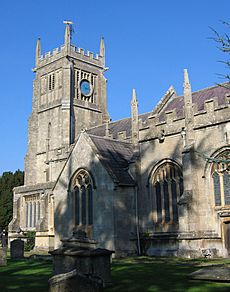
A church was first mentioned in Melksham way back in 1086. The main church, St Michael and All Angels, started in the 1100s. It was made bigger over the centuries. Today, it is a very important Grade II* listed building. As Melksham grew, another church, St Andrew's, was built in 1876 to serve the Forest area.
A Baptist church was built in 1714 and then replaced with a larger one in 1776. By 1850, it had many members and a large Sunday School for children.
Ebenezer Baptist Church was built in 1835. A Methodist church was built on the High Street in 1872. This became the United Church in 1976 when Methodists and Congregationalists joined together.
A Catholic church, St Anthony of Padua, opened in 1939. There is also Queensway Chapel, built in 1967. Melksham also has a long history of Quakerism. Their meeting-house was built in 1698 and rebuilt around 1777. It is now used as offices.
Governance
Melksham has its own local government. Until 1974, the town was run by the Melksham Urban District Council. Now, most important local services are handled by Wiltshire Council. This includes things like schools, roads, social services, and waste disposal.
The town of Melksham also has a town council. This council has fifteen members who are elected by people living in the town. They choose one of their members to be the Mayor of Melksham for one year. The town council helps run the Assembly Hall, which is a place for events. Since 2019, they also look after the town's play areas and the King George V playing field.
The areas just outside Melksham are managed by a different local council called Melksham Without. For national elections, Melksham is part of the Melksham and Devizes area.
Geography
The area known as Melksham includes Melksham Forest. This used to be a separate small village about 1.3 kilometers (0.8 miles) northeast of the town, but now it's a part of Melksham. It has an Anglican church.
The nearby area of Melksham Without includes several villages and parts of Melksham, such as:
- Bowerhill: A large community with many homes and a big industrial area.
- Hunter's Meadow: A new housing area built in the 2020s, north of Bowerhill.
- Berryfield: A village south of Melksham, often thought of as part of the town.
- Beanacre: A village to the north, also often seen as a northern part of Melksham.
Demography
In the 1800s, the number of people living in Melksham changed a lot. It grew from 4,000 people in 1801 to 5,800 in 1851. Then, it went down to 2,100 by 1891. In the 1900s, the population slowly grew at first, then much faster. By 2001, there were 14,204 people. In 2011, the number increased a bit to 14,677.
If you include nearby areas like Berryfield and Bowerhill, the total population of the built-up area was 19,357 in 2011.
Economy
Melksham has a variety of industries. One well-known company is Avon Rubber. They used to own a large tire factory in the town center. That factory is now home to Cooper Tire & Rubber, which is part of the American Goodyear company. It's a big employer in the town, making Cooper Avon and Avon Tyres. However, this factory is set to close by the end of 2023.
In 2000, Avon Rubber plc moved to a new, specially built factory about 3 kilometers (2 miles) south of town. They employ over 300 people and make products like gas masks. Melksham is also home to Knorr-Bremse, a company that designs and makes braking systems for trains.
Melksham has a busy business area. It's also close to bigger shopping centers in Bath, Chippenham, Devizes, and Trowbridge. The town has many local shops, charity shops, and five supermarkets: Asda, Sainsbury's, Waitrose, Lidl, and Aldi.
Culture and Community
Melksham has an Assembly Hall and the Rachel Fowler Centre, which host many events. Many villages nearby also have community halls with different activities. Melksham Oak Community School offers sports and cultural facilities for everyone in Melksham to use.
The town holds an annual 'Party in the Park' usually in July. This event includes fun rides, a fireworks show, and a stage with music and dance. There's also a carnival parade through the town with decorated floats. These floats promote local businesses and clubs and help raise money for charity.
Media
You can get local news and TV shows from BBC West and ITV West Country. TV signals come from the Mendip TV tower.
The Melksham Independent News is the town's local newspaper. It's owned by a family and started in 1981. Over 13,700 copies are given out every two weeks across the town and nearby villages. Other regional newspapers like the Gazette and Herald and Wiltshire Times also cover Melksham.
For radio, you can listen to BBC Radio Wiltshire on 104.3 FM, Heart West on 102.2 FM, and Greatest Hits Radio South West on 107.5 FM.
Sport and Leisure
The Melksham Community Campus opened in 2022. It was built by Wiltshire Council next to Melksham House. This campus has a swimming pool, a library, a sports center, and council offices.
Melksham has a non-League football club called Melksham Town F.C.. They play at the Oakfield Stadium, which opened in 2017. In 2018, the club moved up to the Southern League. The Melksham Rugby Union Club also plays at the Oakfields complex on different fields.
The Wiltshire School of Gymnastics is located at Bowerhill. Melksham also has a cricket club. They play their home games at the Melksham House ground. The club has teams for both young people and adults.
Transport
Melksham railway station is on a train line that goes from Chippenham to Trowbridge. Trains run about every two hours in both directions on weekdays. These trains are run by Great Western Railway.
Bus companies like Faresaver and First West of England serve Melksham.
The town is on the A350 primary route. This road connects the M4 motorway (near Chippenham) to Poole on the south coast. In February 2020, the government approved a plan to change the route of the A350 to the east of Melksham.
Education
Here are the primary schools within Melksham:
- Aloeric Primary School
- Forest & Sandridge C of E Primary School
- The Manor C of E VC Primary School
- River Mead School
Primary schools close to Melksham include:
- Bowerhill Primary School
- Churchfields Primary School, Atworth
- Seend C of E Primary School
- Shaw C of E Primary School
- St Mary's Broughton Gifford Primary School
There is one secondary school for Melksham: Melksham Oak Community School. It opened in 2010 at Bowerhill. This school replaced The George Ward Technology College.
Stonar School, which is an independent school for all ages, is nearby at Atworth.
Dinosaur
Melksham is famous for a prehistoric crocodile species found in the town! This creature is called Ieldraan melkshamensis, or the Melksham Monster. It was about 3 meters (10 feet) long. It was a top hunter in the waters around the UK during the Jurassic period.
The fossil of this monster had been at the Natural History Museum since 1875. But in 2017, a team from the University of Edinburgh studied it and identified it as a brand new species.
Notable People
Many interesting people have connections to Melksham:
- Edward Barnwell (1813–1887), a schoolmaster and archaeologist, owned Melksham House.
- Matthew Bound, a footballer.
- Edmund Wright Brooks (1834–1928), a Quaker who helped many people.
- John Fowler (1826–1864), an engineer who worked with farming machines.
- Ken Gill (1927–2009), a trade union leader and artist, grew up in Melksham.
- Sidney Goodwin (1910–1912), born in Melksham, was a child victim of the Titanic sinking.
- Julia de Lacy Mann (1891–1985), an economic historian, retired to Melksham.
- Henry Moule (1801–1880), who invented the earth closet.
- Andy Park, known as "Mr. Christmas."
- Diana Ross, a children's author, lived nearby in Shaw.
- Brad Scott, an MMA fighter.
- Ann Yearsley (c. 1753–1806), a poet, died in Melksham.
Images for kids
See also
 In Spanish: Melksham para niños
In Spanish: Melksham para niños


